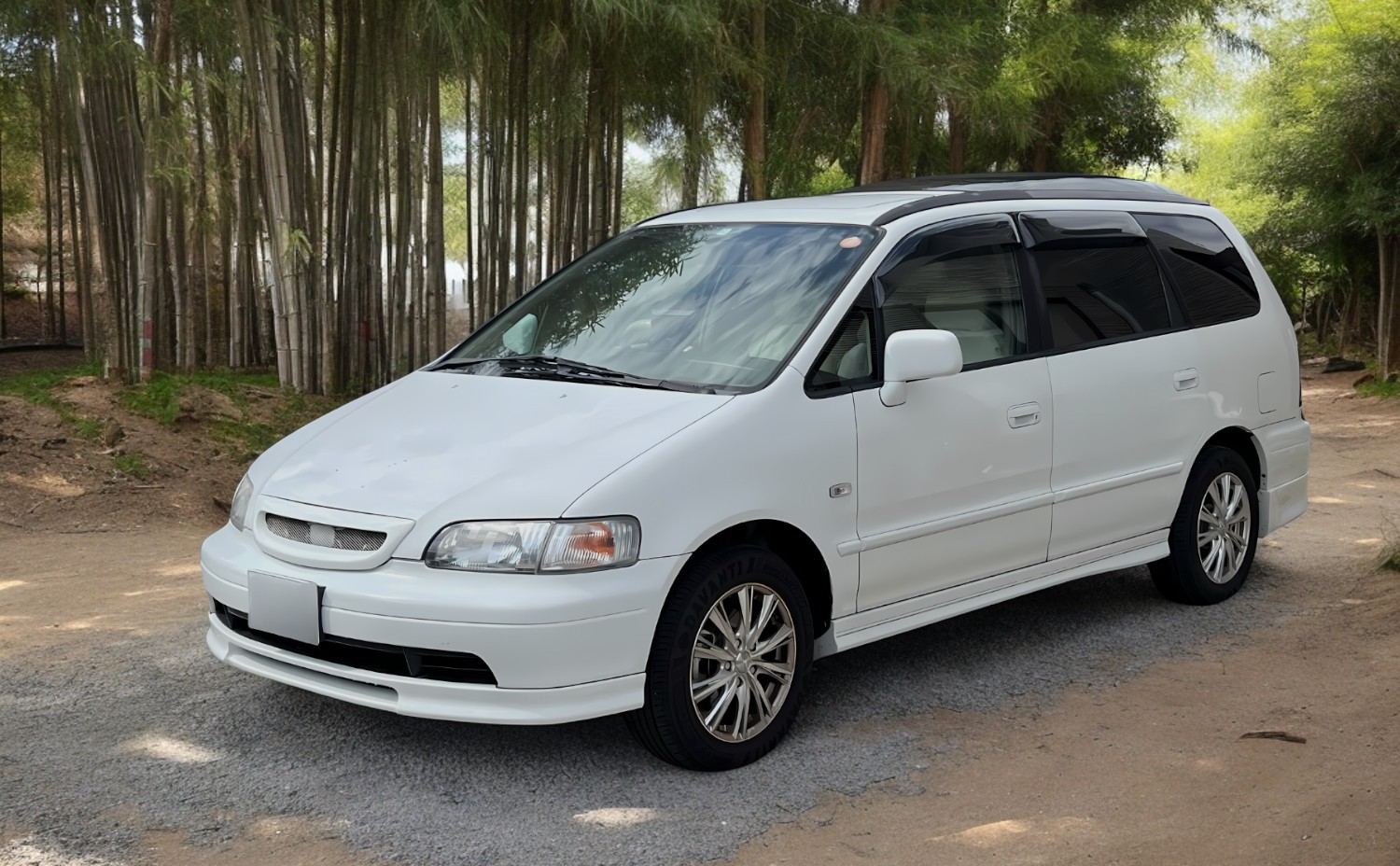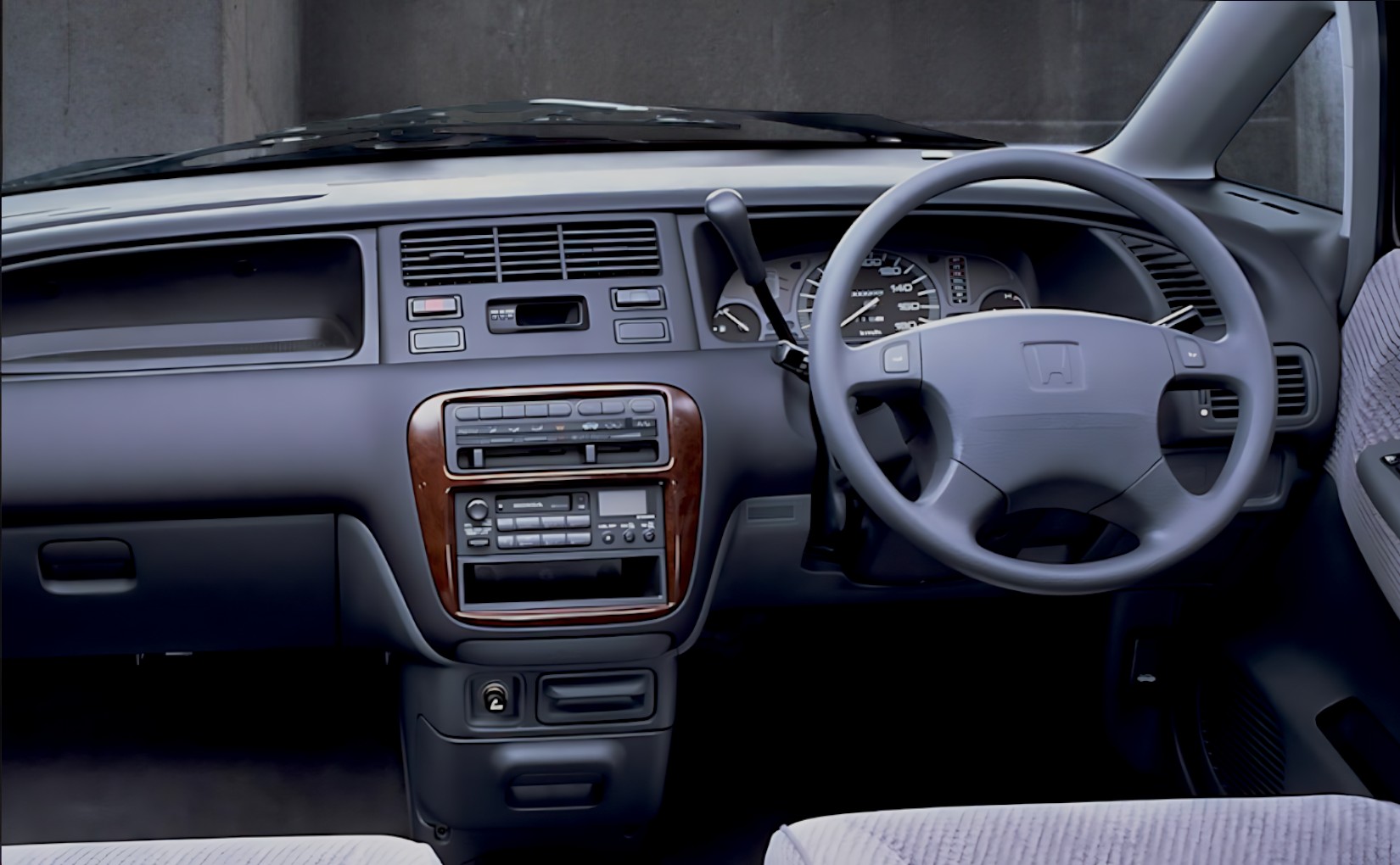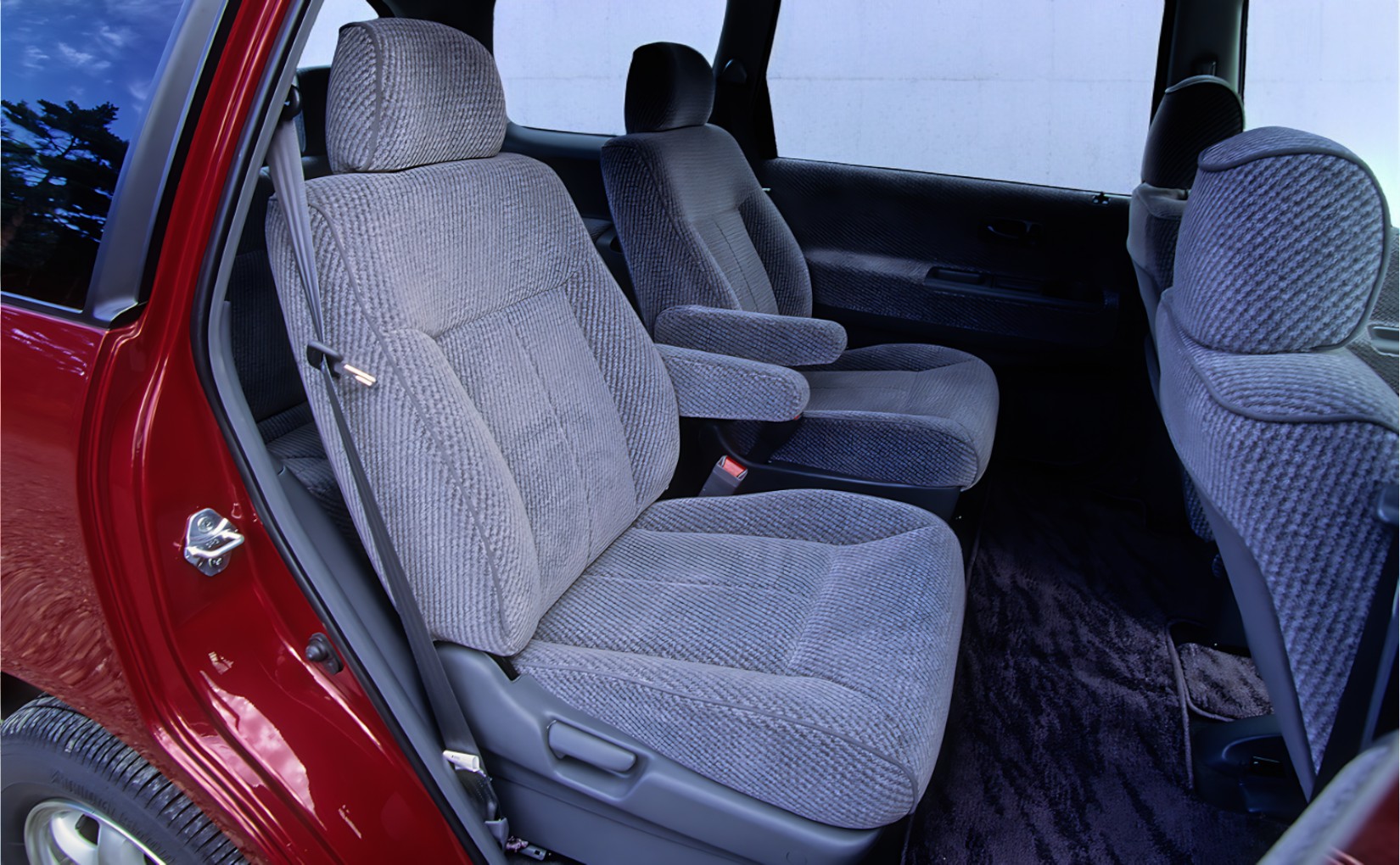Honda Odyssey
Is the RHD Honda Odyssey minivan the perfect postal delivery vehicle? With it’s massive rear cargo space, Japanese reliability, 2WD or 4WD variants, and good fuel economy, you may think so. Learn more below.
Jump To Section
The First Generation Odyssey (1994-1999)
In the early 1990s, Honda faced declining sales and needed a competitive recreational vehicle (RV). To address this, Honda developed the Odyssey, basing it on the Accord platform to keep costs down.
Launched in 1994, the Japanese market RHD Odyssey featured a unique design. Instead of sliding doors, it had front-hinged doors, which was unusual at the time. The double-wishbone suspension setup provided sedan-like handling. This innovation led to its unexpected popularity, significantly boosting Honda’s sales and marking the beginning of a new era in minivan design. One of its key features was its seating arrangement, which could accommodate up to seven passengers. The rear seats could be folded flat into the floor, providing a large cargo space when needed.
Although Honda initially set a sales target of 4,000 units per month, strong demand quickly forced them to boost production. By the end of its five-year run, the first-generation Odyssey had sold 433,028 units.
This first-generation Odyssey was powered by a 2.2-liter 4-cylinder engine, providing adequate power for its size while maintaining good fuel efficiency. Safety features included dual airbags and ABS, which were advanced for the time. The interior was designed with convenience in mind, offering various storage compartments and easy-to-use controls.


The Second Generation Odyssey (1999-2004)
The second-generation Honda Odyssey, introduced in October 1999, was designed specifically for North American consumers, who required a larger and more powerful minivan than the first generation.
This new generation featured significant changes, including the introduction of a 3.0-liter V6 engine that provided greater power and improved performance. It also included a new 5-speed automatic transmission, a substantial upgrade from the previous generation’s 4-speed transmission. The exterior design was more streamlined and modern, giving it broader appeal.
The second-generation Odyssey came with enhanced safety features, including side airbags, ABS, brake assist, and traction control, which were advanced for the time. These improvements, combined with the vehicle’s larger size and increased power, helped solidify the Odyssey’s reputation as a top choice in the Japanese (JDM) minivan segment, ensuring its continued success in the market.
Although it continued to sell well, the second-generation Honda Odyssey did not match the first generation’s sales figures. It sold 270,307 units over its run, which was still impressive but not quite up to the stellar performance of the first generation.
RHD Honda Odyssey Minivans For Postal Routes
As a rural letter carrier, you’ll find the right-hand drive first-generation Honda Odyssey RA models, produced for the Japanese market, to be an excellent choice for your mail route. These vehicles are renowned for their impressive fuel economy, with the 2.2L 4-cylinder engine offering about 24 mpg, helping you get the most out of your fuel allowance.
The spacious interior and flexible seating arrangements provide ample cargo capacity for large volumes of mail and packages, so you can maximize your delivery efficiency and make your workday smoother and more productive.
Both the first and second-generation models offer large cargo capacities, which means lots of space for letters and packages on your route:
Cargo Space: 1st Generation Model
- With all seats in place: Approximately 11.1 cubic feet.
- With the third row folded down: Approximately 38.9 cubic feet.
- With the 2nd and 3rd rows folded down: Approximately 90.9 cubic feet.
Cargo Space: 2nd Generation Model
- With all seats in place: Approximately 13.1 cubic feet.
- With the third row folded down: Approximately 39.8 cubic feet.
- With the 2nd and 3rd rows folded down: Approximately 91.1 cubic feet.
Additionally, the RA1 and RA2 models come with the option of 4WD, vital for rural mail routes on snowy or muddy roads. Finally, the advanced double-wishbone suspension system in these models offers a smooth and stable ride, reducing fatigue over long shifts.
RHD Odyssey And Jeep Cherokee Compared
First, let’s see how that all-important cargo capacity stacks up with that RHD stalwart, the XJ model Jeep Cherokee.
With all seats in place the Cherokee has approximately 32.9 cubic feet of cargo space, and with the second row folded down that grows to approximately 69.0 cubic feet. So, it’s clear that the Honda Odyssey, both first and second-generation models, offers significantly more cargo space when all seats are folded down.
Add to this the considerably better fuel economy of the Odyssey, which is 24 mpg for the first-generation 2.2L models, and 25 mpg for the second-generation 2.3L models – which is far ahead of the Jeep’s combined rating of 17 mpg.
The right-hand drive Honda Odyssey is the clear winner.


Specifications
First Generation: October 1994 to October 1999
Honda Odyssey RA1
- Engine: 2.2L (131.5 cu in) 4-cylinder
- Transmission: 4-speed automatic (4AT)
- Drive: Available in both FF (front-wheel drive) and 4WD (four-wheel drive)
- Seating: 6 or 7 seats
- Fuel Efficiency: Approximately 24.0 mpg (FF), 21.7 mpg (4WD)
- Dimensions: 187.0 in length x 69.7 in width x 64.8-65.9 in height
- Weight: Around 3240-3330 lbs (FF), 3370-3460 lbs (4WD)
- Notable Features: Double wishbone suspension, dual airbags, ABS, navigation system, leather seats, sunroof options
Honda Odyssey RA2
- Engine: 2.3L (137.5 cu in) 4-cylinder
- Transmission: 4-speed automatic (4AT)
- Drive: Available in both front-wheel drive (FF) and full-time 4WD
- Seating: 6 or 7 seats
Fuel Efficiency: Approximately 21.6 mpg - Dimensions: 187.0 in length x 69.7 in width x 65.4-66.5 in height
- Weight: Around 3,370 to 3,590 lbs
- Notable Features: Similar to RA1, but with enhanced safety features including dual airbags and ABS, and improved interior amenities
Honda Odyssey RA3
- Engine: 2.3L (137.5 cu in) 4-cylinder VTEC
- Transmission: 4-speed automatic (4AT)
- Drive: FF (front-wheel drive)
- Seating: 6 or 7 seats
- Fuel Efficiency: Approximately 24.9-26.3 mpg
- Dimensions: 187.6 in length x 69.7-70.5 in width x 64.8-65.9 in height
- Weight: Around 3330-3370 lbs
- Notable Features: Improved fuel efficiency, additional trim levels like Aero Spirit, pop-up roof options
Honda Odyssey RA4
- Engine: 2.3L (137.5 cu in) 4-cylinder VTEC
- Transmission: 4-speed automatic (4AT)
- Drive: Full-time 4WD
- Seating: 6 or 7 seats
- Fuel Efficiency: Approximately 24.4 mpg
- Dimensions: 187.6 in length x 69.7-70.5 in width x 65.4-66.5 in height
- Weight: Around 3480-3520 lbs
- Notable Features: Similar to RA3 but with full-time 4WD, additional trim levels like Field Deck with higher roof options
Honda Odyssey Prestige RA5
- Engine: 3.0L (2997cc) V6
- Transmission: 4-speed automatic (4AT)
- Drive: FF (front-wheel drive)
- Seating: Available in both 6 and 7 seat configurations
- Fuel Efficiency: Approximately 20.7 mpg
- Dimensions: 190.6 in length x 70.5 in width x 64.8-65.9 in height
- Weight: Around 3530-3560 lbs for 6-seat configurations, 3550-3565 lbs for 7-seat configurations
- Notable Features: Higher-end trim levels include features like leather seats, power driver’s seat, cruise control, and a 6-speaker audio system with CD player. Variants include standard VG, VG Touring with aero parts and sunroof, and the top-end VZ trim.
Second Generation: December 1999 to October 2003
Honda Odyssey RA6
- Engine: 2.3L (137.5 cu in) 4-cylinder
- Transmission: 4-speed automatic (4AT)
- Drive: FF (front-wheel drive)
- Seating: Available in both 6 and 7 seat configurations
- Fuel Efficiency: Approximately 25.9 mpg
- Dimensions: 188.0 in length x 70.9 in width x 64.2 in height
- Weight: Around 3540-3580 lbs
- Notable Features: Variants include Standard, Premium Sound Spirit, and Absolute trims. Features include enhanced audio systems, leather seats, power options, and advanced safety features like ABS and airbags.
Honda Odyssey RA7
- Engine: 2.3L (137.5 cu in) 4-cylinder
- Transmission: 4-speed automatic (4AT)
- Drive: Full-time 4WD (four-wheel drive)
- Seating: Available in both 6 and 7 seat configurations
- Fuel Efficiency: Approximately 24.9 mpg
- Dimensions: 188.0 in length x 70.9 in width x 65.2 in height
- Weight: Around 3690-3740 lbs
- Notable Features: Variants include standard, Premium Sound Spirit, and Absolute trims. Features include 4WD capability, improved suspension for off-road conditions, and advanced audio and navigation systems.
Honda Odyssey RA8
- Engine: 3.0L (183 cu in) V6
- Transmission: 5-speed automatic (5AT)
- Drive: FF (front-wheel drive)
- Seating: Available in both 6 and 7 seat configurations
- Fuel Efficiency: Approximately 21.6 mpg
- Dimensions: 190.4 in length x 70.9 in width x 64.2 in height
- Weight: Around 3720-3740 lbs
- Notable Features: Variants include VG and VZ trims. Features include luxury options like leather seating, power adjustments, and enhanced audio systems.
Honda Odyssey RA9
- Engine: 3.0L (183 cu in) V6
- Transmission: 5-speed automatic (5AT)
- Drive: Full-time 4WD (four-wheel drive)
- Seating: Available in both 6 and 7 seat configurations
- Fuel Efficiency: Approximately 21.2 mpg
- Dimensions: 190.4 in length x 70.9 in width x 65.2 in height
- Weight: Around 3850-3880 lbs
- Notable Features: Variants include VG, VZ, and Absolute trims. Features include 4WD capability, premium interior materials, advanced safety systems, and high-end audio options.

